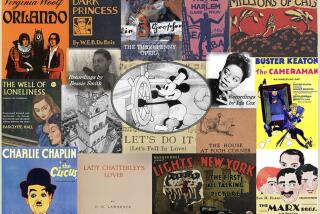A COLORFUL COPYRIGHT CAMPAIGN
Color Systems Technology, one of two companies giving old black-and-white films computer paint jobs, bought the back page of Thursday’s Daily Variety to run a list of movies and TV shows that it has colorized or is about to.
Considering the amount of criticism being leveled at computer colorization by the creative community and film critics, the ad comes off as one of the brassiest conceits since Chuck Barris announced he was following “The Gong Show” with “The $1.98 Beauty Show.”
Color Systems is the lucky winner of the Ted Turner Lotto. The Marina del Rey-based company has been assigned by Turner Broadcasting Systems to gussie up 100 of the black-and-white films Turner took away from his brief flirtation with Hollywood moguldom as the owner of MGM.
“Yankee Doodle Dandy,” the 1942 musical classic that displayed James Cagney’s gymnastic dancing skills, was the first delivered item on Turner’s order. Cagney always remembered the film as his favorite and now, thanks to the miracle of colorization, we can see how excited he really was. His head glows most of the time like a flesh-colored jack-o’-lantern.
If you’ve seen the colorized version, you may have also noticed that it includes a copyright line. So does “Miracle on 34th Street,” which Color Systems painted for 20th Century Fox, and “It’s a Wonderful Life,” the Frank Capra Christmas perennial that Colorization Inc., Color Systems’ Toronto-based competitor, did for Hal Roach Studios.
The colorized versions have copyright lines, but they are not technically copyrighted. Not yet. And they may never be.
The U.S. Copyright Office, questioning whether a colorized version of a black-and-white film warrants copyright protection, invited public comment on the issue and will spend months reviewing the material it receives before making that decision.
“We have been aware of the problem for about a year now,” said Dorothy Schrader, general counsel for the Copyright Office. “A lot of times we make these decisions without a public hearing, but this issue is very controversial.”
Schrader said the deadline for written public comment is Dec. 15 and that a decision will be made early next year. If it is decided that colorized black-and-white films are separate creative entities, the office will issue copyright registrations, essentially protecting those versions from copyright infringement for 75 years.
If the decision goes the other way, the colorizers and their customers will have to proceed at their own economic risk. Once movies enter the public domain (more than 17,000 black-and-white films already have and thousands more will in the next decade), they are fair game for anyone with a computer spray can.
The Directors Guild of America made its public comment to the Copyright Office this week by way of a 27-page legal brief in which colorization is described as a “trivial variation” of a work of art. Other guilds and film associations are expected to follow. The Writers Guild of America West, the American Society of Cinematographers and the American Film Institute have all condemned the process.
Most of the criticism of colorization has been based on moral and aesthetic grounds, as in, it is wrong to deface works of art (no matter how colorfully) and--so far at least--the new versions have been laughable abominations. But morality in the entertainment business is treated like a mud vein in a carp, with distaste and general avoidance.
If you intend to send your views on colorization to the Copyright Office (Dept. 100, Library of Congress, Washington 20540), don’t bother hanging your argument on moral or aesthetic hooks. Schrader said that the federal copyright law, updated and re-enacted in 1978, provides no moral rights protection.
“There is a lot of public interest regarding the integrity of film, and the feeling that a copyright should protect the reputations of film makers from having their work used in a detrimental way,” Schrader said. “But the fact is that the federal copyright law doesn’t give any moral rights protection. The only thing we can address is whether (a colorized film) is a new creation.”
Critics compare colorization to rewriting famous novels or musical compositions. Unfortunately, the copyright law doesn’t recognize the parallel. Schrader said films are categorized as “ordinary works made for hire” in copyright terminology and are given fixed terms of protection.
Before 1978, film copyrights were for two terms of 28 years each. However, the copyright holder had to renew it during the 29th year, or it fell into the public domain.
Schrader said that’s what happened with “It’s a Wonderful Life.” The movie was caught in a transfer of ownership during its renewal year and no one thought to fill out the form. Hall Roach Studios spotted it in the public domain, like a calf that had wandered off from the herd, and put its Colorization Inc. brand on it.
If the copyright office registers the colorized version of “It’s a Wonderful Life,” and all the others being rounded up by Hal Roach, the studio could end up with a library of movies, each of them costing a fraction of what it would cost to make their own.
Under the 1978 copyright law, movies are protected for one continuous term of 75 years from the date of release or 100 years from their creation, whichever is shorter. The new law also extended renewals of previously copyrighted films for 48 years, meaning that most of the classic films of the early ‘30s, which would have fallen into the public domain over the next few years, are now protected through the rest of the century.
If the colorized versions of those films are seen as new creations, subject to fresh copyrights, and if the market for colorized films is what Color Systems and Colorization Inc. says it is, it’s a new game. Black-and-white negatives or prints may still exist, but the chances of your seeing them anywhere but in a revival theater--if any of those survive the VCR revolution--are slim.
More to Read
The biggest entertainment stories
Get our big stories about Hollywood, film, television, music, arts, culture and more right in your inbox as soon as they publish.
You may occasionally receive promotional content from the Los Angeles Times.










